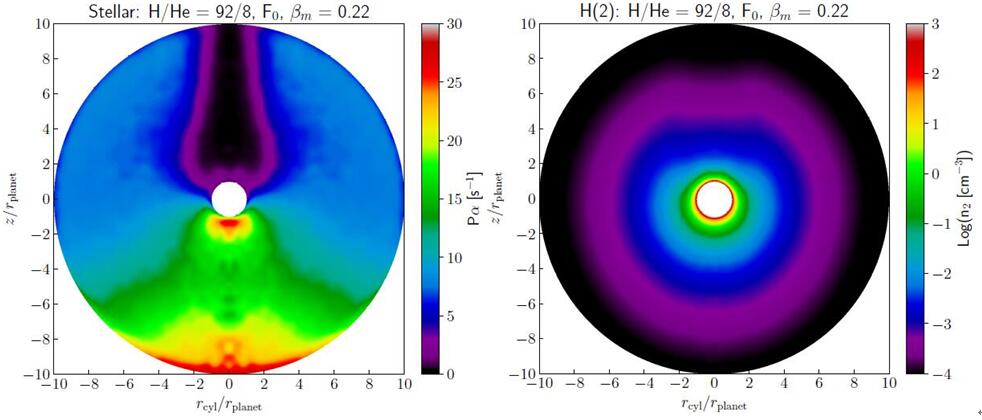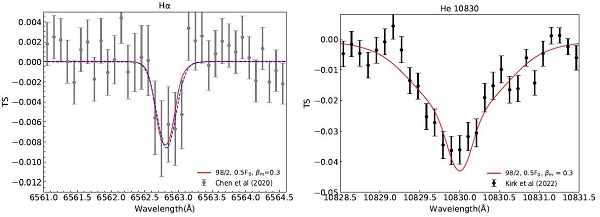YAN Dongdong, GUO Jianheng and LI Lifang from Yunnan Observatories, Chinese Academy of Sciences (CAS), and their co-authors Kwang-il Seon from Korea Astronomy and Space Science Institute, CHEN Guo from Purple Mountain Observatory, CAS, introduced a new method to study the resonance scattering in the planetary atmosphere.
For the first time, the researchers reproduced the observed transmission spectra of the exoplanet WASP-52b at different wavelength bands simultaneously and studied the properties of its hydrogen and helium atmosphere. The results were recently published in The Astrophysical Journal.
Close-in exoplanets receive intense high-energy radiation from their host stars, such as X-rays and extreme ultraviolet (XUV) radiation. In gas-rich exoplanets, the atmosphere may absorb this high-energy radiation, thus heating the atmosphere and causing it to expand to overcome the planet's gravitational potential and escape into the interstellar medium. This phenomenon is known as planetary atmosphere escape, which can cause the loss of a large amount of material from the planet and has important effects on the composition, evolution and even the overall distribution of the planet.
The composition and properties of the planetary atmosphere can be studied by analyzing the absorption of spectral lines at different wavelength bands, for example, the optical band (Hα) and near-infrared band (He λ10830Å) lines, the so called transmission spectra. In some systems, multiple absorption lines have been detected, but the work to simultaneously interpret these observed signals is very rare, especially which explains the transmission spectra of Hα and He λ10830Å. In addition, some studies have shown that the hydrogen to helium abundance ratio in the planetary atmosphere may be different from the solar abundance value (92/8), which requires further studies on the origin or escape of helium in the atmosphere.
Therefore, in this work the researchers used the hydrodynamic atmospheric escape model and the radiation transfer model to simulate the transmission spectra of WASP-52b. They introduced the Monte Carlo model to simulate the Lyα resonant scattering inside the exoplanetary atmosphere for the first time, by assuming that both the stellar Lyα radiation and the planetary atmosphere are in spherical.
By obtaining the distribution of the Lyα scattering rate Pα (as shown in the left panel of Figure 1), the researchers calculated the Hα absorption, which is caused by the hydrogen atoms in the first excited states (as shown in the right panel of Figure 1). They also calculated the distribution of metastable helium atoms in detail. Finally, they simulated the transmission spectra of hot Jupiter WASP-52b in the optical band (Hα) and near-infrared band (He λ10830Å) (see Figure 2). By doing so, they have constrained the level of X-rays and extreme ultraviolet radiation received by the planet, as well as the hydrogen to helium abundance ratio in the planetary atmosphere (which is higher than that of the Sun, at about 98/2), and suggest that hydrogen and helium originate from the escaping atmosphere. The findings can help to constrain the physical paramters of the atmosphere and to better understand its composition and structure.
This work provides a valuable reference for the theory and observation of planetary atmosphere and would be a benchmark in the study of explanetaty atmosphere.
Contact:
YAN Dongdong
Yunnan Observatories, CAS
Email: yand@ynao.ac.cn

Figure 1. The left and right panels show the distribution of Lyα scattering rate and the number density of hydrogen atoms in the first excited state in cylindrical coordinates for the fiducial model, respectively. The white circle represents the planet itself, and surrounding is the planetary atmosphere.

Figure 2. Comparison of model transmission spectra with the observations. The left panel shows the Hα transmission spectrum, where the scatters with error bars are the observed data, and the solid red line is the best-fit model. The hydrogen to helium ratio in the atmosphere of the model is 98/2, the XUV radiation flux is 0.5 times of the fiducial value, and the ratio of the X-ray flux to the total XUV flux, namely, the spectral index, is 0.3. The right panel is the same as the left one, but shows the He λ10830Å transmission spectrum. It can be seen that the best-fit model can simultaneously reproduce both the observations of Hα and He λ10830Å absorption lines well.